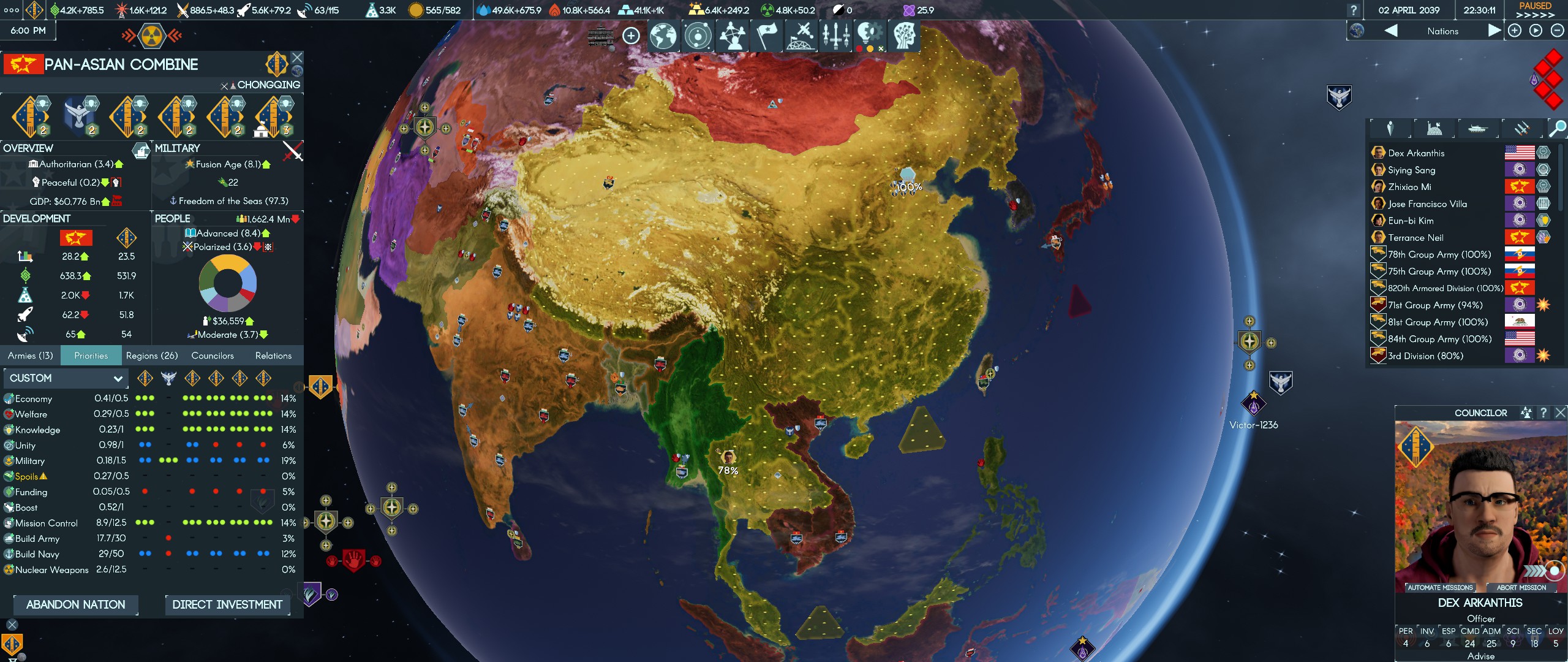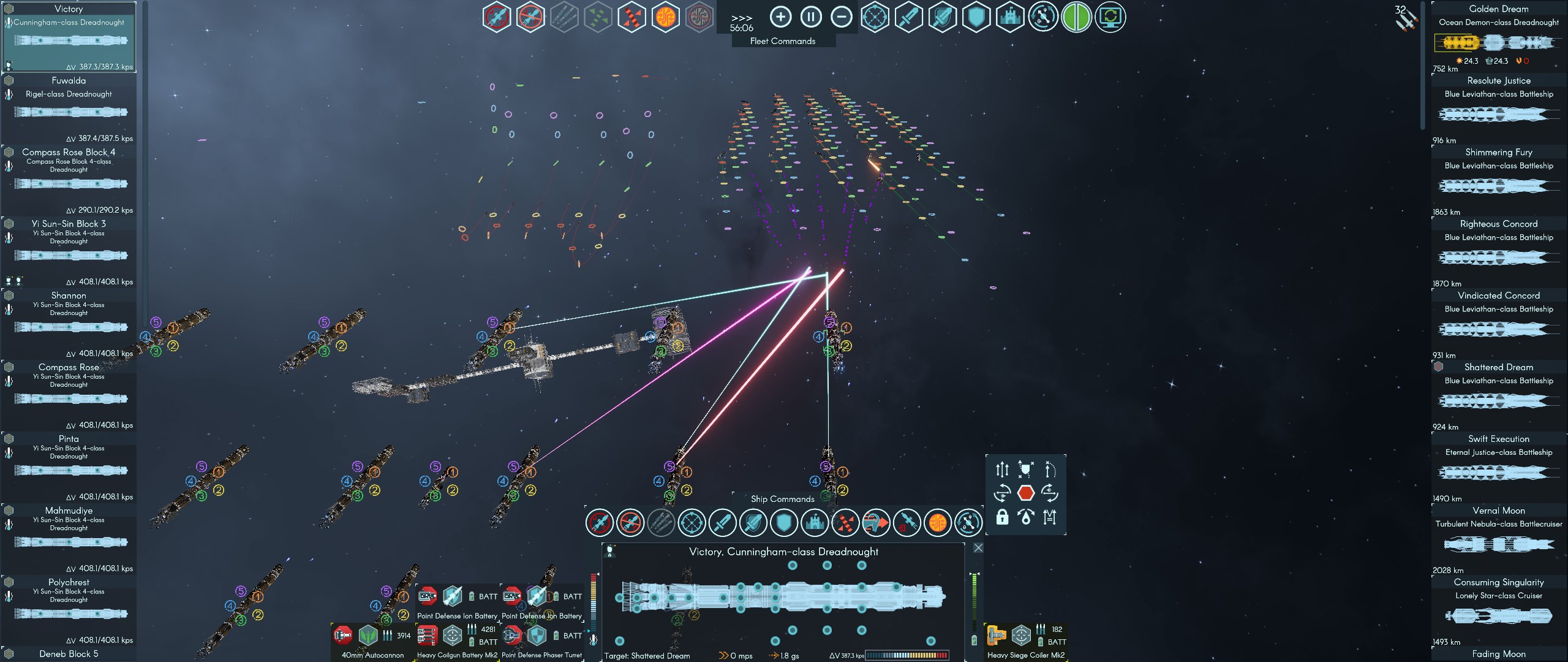- Terra Invicta: An Early Access strategy game that reaches for the stars
- Terra Invicta: winning the long war
- Revisiting Terra Invicta in late 2024
I recently replayed Terra Invicta, a game I loved and covered extensively when it launched in Early Access in late 2022.
Two years on, it’s still recognisably the same game, and still does the same things well. What has changed are the AI’s competence (and the level of challenge), as well as the game’s quality of life and polish.
What do I like, two years on, and how did my game unfold?
Borrowing a concept from Jesse Schell, I like to characterise strategy games as either:
- A “game” — a structured, rules-based challenge where the goal is to win (e.g. Civilization, Master of Orion II or Stars in Shadow, most real-time strategy games); or
- A more aimless “toy” or “interactive narrative generator” (e.g. Crusader Kings, Stellaris).
The beauty of Terra Invicta is that it succeeds on both levels:
- It’s a game with a defined objective — defeating an alien invasion — and a very high skill ceiling. Both times I’ve won, it took me until the 2050s. The best players do it in the 2030s!
- And it’s also an simulator or narrative generator about the world responding to that invasion. On Earth, countries crash-industrialise, invest in science, and redraw their borders in response to the alien threat. In space, we go from recognisable near-future projects (returning to the Moon) to the furthest reaches of the solar system.
This playthrough became a test of how replayable the game is. I changed many things from my first run:
- Chose a different faction (Project Exodus, which aims to build an interstellar colony ship, instead of the XCOM-like Resistance);
- Increased the difficulty (from Normal to Veteran);
- Played on the “Accelerated Campaign” mode, which significantly speeds up variables such as research speed (and almost certainly made the game harder, as the aliens benefit from the bonuses as well); and
- Chose a different starting strategy (prioritising Asia ahead of Europe and North America).

And while the flow of the game remained the same, the details unfolded differently. The results were humbling. The normal progression of a Terra Invicta game looks like this:
- The first order of business is winning support from countries on Earth, then using their space programs to establish early outposts on the Moon and Mars.
- Over time, scientific research and the resources from those early mines provide the springboard to expand throughout the solar system: Mercury, the asteroid belt, and the moons of Jupiter.
- Eventually, players have the resources and technology to build a fleet that can challenge the aliens.
- Good players can establish a commanding lead at the start, get into space early, aggressively challenge the aliens and deny them access to the Belt’s resources, and then snowball from there. The best players can even beat the aliens to Jupiter.
So how did I do?
- I was too slow on Earth (and hence to the Moon and Mars), got blasted out of Mercury orbit (twice!) before finally managing to secure it, and never succeeded in seizing the initiative. The furthest I made it was Io, the Jovian moon.
- Left mostly to their devices, the aliens amassed large, powerful fleets and repeatedly sent them against the inner planets.
- To win the game, I had to farm a stupendous quantity of resources by destroying alien fleets, which I mostly did on the defensive. This always felt slightly touch and go — even though my late game spacecraft were powerful and could win against several times their number, I never had the resources to build as many as I wanted, and they certainly weren’t expendable. Committing my fleets always felt like a risk.
This points to one more thing the game does well — encouraging players to be resilient. Strategy games tend to impose an “up and to the right” mindset — partly because setbacks, such as losing veteran soldiers in XCOM, can be so devastating, and partly because losing progress is often frustrating rather than fun. Here, perseverance pays off.

Tougher…
After I won my first game, I suggested several possible changes that might keep the game challenging, such as a better AI and new late-game alien tools. Nearly every item on my wish list is now in the game:
- The aliens stay in formation, use much heavier armour, and are less prone to squandering resources on bombarding well-defended targets, negating several of their weaknesses at launch. (In that last example, the pendulum might have swung too far — now they’re probably too cautious about bombardment.)
- They mass their forces into terrifyingly large doom stacks instead of allowing themselves to be defeated in detail. At first, having to fight alien fleets of 80-100 ships was daunting. When I beat the 100-ship fleets, the aliens combined their forces into 200-ship fleets. After I beat a 200-ship fleet, I saw a 300-ship fleet. At that point, instead of fighting the 300-ship fleet, I just sent up unmanned decoys to distract it…
- On top of their better AI, the aliens now field more advanced weapons over time. At launch, it was trivial for a late-game fleet to shoot down a barrage of incoming alien missiles. Not any more!
- Even the AI for the other terrestrial factions seems to have improved. They are more aggressive and, on rare occasions, could defeat small alien fleets.
Those changes worked. Right to the end of my latest game, I never felt I was running away with things. While I brought Earth mostly back under control, the aliens remained a lethal threat in space.
While there is still room to improve, particularly for the other human factions, the game has already come a long way.


… but still fair
Despite its high skill ceiling and learning curve, Terra Invicta is also surprisingly forgiving, or at least more forgiving than it looks:
- I was massively overconfident in my ability to jump back in at a higher difficulty level, despite not having played in around 18 months.
- I horrifically botched the early game, exacerbated by not doing what worked the first time.
- I compounded my mistakes by angering the aliens and their sympathisers well before I was ready. Instead, I should probably have played to my faction’s strength, the ability to stay fairly neutral early on.
- And yet, I still won.
Quality of life is improving
The game’s interface and user-friendliness have also improved since launch. For example, players can now:
- Automate characters on Earth;
- Set characters’ orders to repeat;
- Sort bases by their resource income — also useful when looking for targets to grab;
- Rally newly built fleets; and
- Batch move armies.
These add up to a better, less painful experience, although again, there is still room to improve. For instance, I’d love to be able to automatically set characters to hide when detected by enemies. The upcoming patch is set to address another weakness, the clunky tech tree interface.
Conclusions
Terra Invicta has come a long way from launch. Back then, I said that it “may become one of the all-time strategy greats”. Two years on, it’s well on its way towards that goal, thanks to a more competent AI, more challenging late game, and better QoL.
More improvements — and new game mechanics — are on their way in the upcoming 0.4.42 patch, which the developers have been working on for some months.
If Terra Invicta continues on this trajectory, I think it can fulfil its promise by the time version 1.0 rolls around.
Discover more from Matchsticks for my Eyes
Subscribe to get the latest posts sent to your email.

Love the detailed update, sounds like it’s really coming along nicely!
How many hours did your second game take?
Thanks, Gunner! Yep – definitely coming along well.
Based on Steam play time (so including AFK), I’d estimate around:
– 150 hours the first time (although a lot of this was on an old, laggy PC, and I also reloaded/replayed years of in-game time);
– 80-90 hours the second time.
So, still a long game, but much faster the second time.